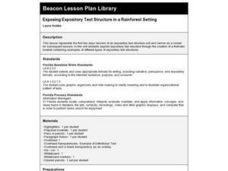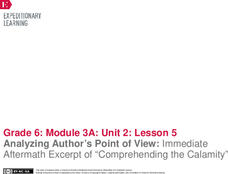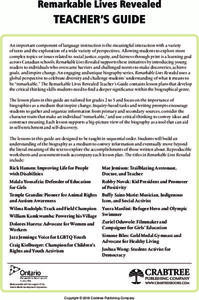Curated OER
Introduce Vocabulary: Dolphin's First Day (Zoehfeld)
Travel out to sea as scholars learn vocabulary in context through Kathleen Zoehfeld's informational book Dolphin's First Day. Go over the new words scholars will hear before reading: approach, coast, expert, feeble, gaze, murky, propel,...
Idaho State Department of Education
Lessons for Social Studies Educators
Point of view, purpose, and tone: three concepts readers of primary and secondary source materials must take into account when examining documents. Class members view a PowerPoint presentation and use the SOAPS strategy to identify an...
Illinois State Board of Education
Common Core Teaching and Learning Strategies
Here's a resource that deserves a place in your curriculum library, whether or not your school has adopted the Common Core. Designed for middle and high school language arts classes, the packet is packed with teaching tips, materials,...
Syracuse City School District
Reading Comprehension Unit Plan
A unit plan uses short texts to teach literary elements such as theme and characterization. Included are passages by authors such as Walter Dean Myers and Sandra Cisneros. Activities include quick writes, filling in graphic organizers,...
Curated OER
Tuck Everlasting Unit
Natalie Babbitt's award winning fantasy, Tuck Everlasting, is the anchor text in a unit plan that focuses on identifying similes, metaphors, imagery, and personification in the text and analyzing how these elements effect the development...
Curated OER
New Information
Young readers explore informational texts as they read a text entitled Giant Pandas by Gail Gibbons. The teacher will begin by explaining that one characteristic of informational texts is that they teach the reader new information and...
Curated OER
Using a Preview Checklist with Informational Text
Sixth graders identify information from texts by working in pairs using Wikki Stix or highlighting tape to locate, mark, and read items on preview checklist. Students then compare what they marked with what another pair marked.
Curated OER
Identifying Symbols
Identify symbols within text and explain what they mean. Sixth graders examine Home of the Brave and identify recurring pictures in the text and discuss what they mean. They then choose a symbol from the text and explain what it means...
Curated OER
Exposing Expository Text Structure in a Rainforest Setting
Students create a thematic booklet containing examples of different types of expository text structures. They explore a variety of expository text structures.
Curated OER
Lesson 2: Identifying an Author's Purpose (part 2)
Keep reinforcing the concept of author's purpose with a practice activity. After discussing the three purposes of writing, third graders will complete a graphic organizer intended to help them pin point textual evidence that proves...
Curated OER
Identifying the Problem and the Solution in a Story
Story elements: the problem and the solution. Help your youngsters identify these elements by reading Bringing Down the Moon, by Jonathan Emmett. After a class discussion and chart creation discussing problems and solutions from past...
Curated OER
Identifying Information from Fiction
A solid comprehension strategy is used to aid learners in better understanding what they read. They are introduced to the way good readers ask questions while their reading to understand what's going on in a story. The class reads...
Curated OER
Text Structures in Science Writing
Middle schoolers recognize that science writing is organized in identifiable patterns called text structures. Understanding and using these different text structures help refine students' abilities to read and write in science.
Curated OER
Outline It!
Fourth graders investigate how outlining can aid in comprehending text. In this reading comprehension instructional activity, 4th graders outline an article they read in groups of two. Students take turns reading the article, identifying...
Curated OER
Identifying Main Idea and Supporting Details - The Stonecutter's Wish
Students identify details that support the theme of a story. In this main idea or theme lesson, students view a video of "The Stonecutter's Wish." Students are given a graphic organizer to use as they discuss the main idea of the...
Curated OER
Context Clues, Plot Structure, Conflict, and Personal Narrative Essay
What are the elements of a personal narrative? Get your class talking by reading "The Necklace" and "A Dangerous Game." The lesson focuses primarily on defining certain vocabulary terms (like context clues, plot, conflict, climax, etc.)...
EngageNY
Analyzing Author’s Point of View: Immediate Aftermath Excerpt of “Comprehending the Calamity"
Analyze that! Scholars continue reading and analyzing a primary source about the immediate aftermath of the 1906 San Francisco fire and earthquake. Then, individuals use graphic organizers to identify the author's point of view.
Alabama Learning Exchange
Who, What, When, Where, Why, How?
Your youngsters are just starting to read texts and pull out important information. Use this graphic organizer with any text to help them practice identifying the who, what, when, where, why, and how of a text. Although the format of the...
DeKalb County Schools
Compare/Contrast
A series of reading activities is sure to engage your young readers! Based on comparing and contrasting ideas, the packet provides opportunities to compare characters, themes, texts, and other elements of fiction.
Crabtree Publishing
Remarkable Lives Revealed
Six lessons make up a unit all about biographies. Scholars read about a remarkable life while taking notes and identifying characteristics of the biographical genre. Readers examine the tale's obstacles, accomplishments, and sequence of...
Curated OER
Everyone's a Critic: Analyzing Sitcoms as Cultural Texts
Start by defining the word sitcom with the goal of launching a discussion. What exactly is a sitcom? How is a sitcom different from sketch comedy, drama, and reality television? Class members give examples, remember storylines they've...
National Park Service
A Tale of Two Men
Theodore Roosevelt and the Marquis de Mores were both born in 1858, and both came to the Dakota territory in 1883, but they influenced the developing country of America in different ways. Elementary and middle schoolers apply written and...
Curated OER
SEQUENCING A STORY WITH PICTURES: TEXT AND TALK
Third graders create a graphic organizer. They draw illustrations that show the beginning, middle and end of a trip they took to visit a friend or a relative. They write age-appropriate text to accompany each drawing. They tell...
Curated OER
Lesson 1: Identifying Information
Factual books about animals are great for sparking interest in non-fiction text. Little ones will love learning about the foods animals eat as they practice identifying facts in a text. They chart the information they've learned by...

























